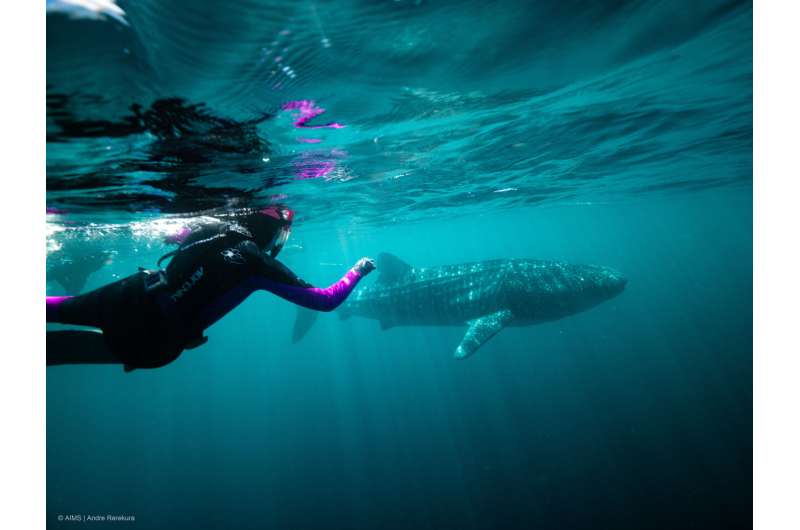Small genetic clues to track the ocean's elusive gentle giants

A new research tool involving the simple task of filling a bottle with seawater could revolutionize how scientists track individual whale sharks and monitor their populations.
The new research from the Australian Institute of Marine Science (AIMS) and UWA Oceans Institute has used the smallest genetic clues in the seawater to track these gentle giants through a method called 'eDNA haplotyping."
Ph.D. researcher and lead author Laurence Dugal said while environmental DNA (eDNA) has been used in the past to monitor the presence of certain species, this new method used eDNA to answer an entirely different question.
"Our new method has taken this incredible leap to detect the genetic signature of individual whale sharks just by analyzing the seawater," she said.
"We have moved beyond species detection and into the realm of population genetics—we've opened a new door in what is possible with eDNA."
Despite their large size, whale sharks are notoriously challenging to track. But like all marine species, whale sharks shed their unique DNA codes into the ocean—known as environmental DNA or 'eDNA' – via skin, feces, blood, mucus, sperm and other biological material.
Scientists collected this eDNA by visiting known whale shark 'hot spots' at Ningaloo Reef, where the team swam behind whale sharks and filled small bottles with seawater. The team then analyzed the seawater samples through a process called eDNA haplotyping.
To confirm the signature of each shark the team also collected tissues samples of 28 whale sharks and compared the results.
"The results were incredibly accurate—the tissue biopsies successfully matched, with high accuracy, to all the individual whale shark's eDNA," Ms Dugal said.
"Up until now, we have only been able to get DNA samples through tissue biopsies, which is logistically difficult, expensive to collect and require invasive sampling techniques."
AIMS and UWA Oceans Institute scientist Dr. Luke Thomas said the research could go beyond whale sharks and be applied to other species at risk.
"This new method is faster, cheaper, highly accurate, easier to scale up and minimally invasive," he said.
"It has the potential to radically change the way we monitor and track megafauna species.
"It could help answer global population-level questions for other megafauna, such as sharks, rays, marine turtles or dugongs."
AIMS Principal Research Scientist Dr. Mark Meekan said endangered whale sharks were an integral part of the ecology at Ningaloo World Heritage Area and are worth $20 million per year in the ecotourism industry of the region.
"AIMS has been leading the research on whale sharks for decades at Ningaloo—a known hot spot for these majestic giants," he said.
"Our research has mapped and tracked whale sharks to examine their behavior, feeding patterns, growth and migration.
"It is important our marine environments are responsibly managed to ensure we can use the ocean and its resources sustainably while preserving the future of whale sharks."
This study was in collaboration with AIMS, UWA Oceans Institute, Curtin University, and a leading eDNA research lab at Aarhus University, Denmark.
The research paper "Individual haplotyping of whale sharks from seawater environmental DNA' was published in Molecular Ecology Resources.
More information: Laurence Dugal et al, Individual haplotyping of whale sharks from seawater environmental DNA, Molecular Ecology Resources (2021). DOI: 10.1111/1755-0998.13451
Journal information: Molecular Ecology Resources
Provided by Australian Institute of Marine Science (AIMS)

















